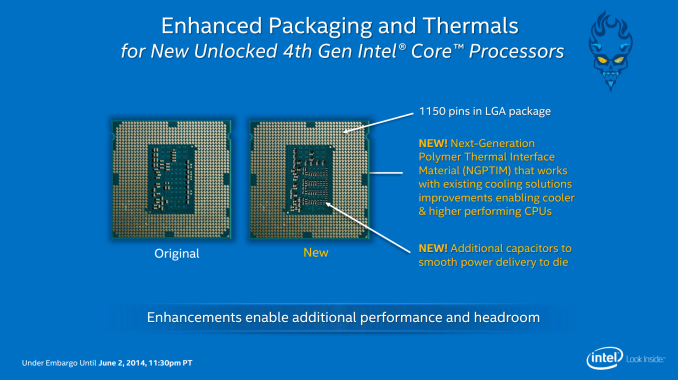Devil’s Canyon Review: Intel Core i7-4790K and i5-4690K
by Ian Cutress on July 11, 2014 10:00 AM EST- Posted in
- CPUs
- Intel
- Haswell
- i7
- Overclocking
- Devil's Canyon
- i5
- 4790K
- 4690K
Conclusions
End-users with CPU intensive workloads always feel justified in requesting for more performance. The only question is if that performance is required at the expense of power, and if the CPU company feel satisfied they can offer a higher performance component with absolute stability. Over the past three generations, Intel CPUs at equal frequency have offered a 5-10% performance boost over the previous generation, usually around the same power envelope. Because 2014 would seem to be a year where there is no major generation change for the mainstream market segment, in order to provide that 10% boost, they have had to go directly at clock speeds.
With the clock speed change, the package is also adjusted in two distinct ways. The first is to add extra decoupling capacitors on the PCB, allowing the voltage regulator on the die to deliver cleaner power to where it needs to go. The second addresses the issue of temperature, whereby the heat generated by the processor is removed. By adjusting the thermal interface material, Intel hopes to have a CPU that is ~10C cooler than the original Haswell CPUs at the same frequency and voltage. This latter part is directly observable, and even when overclocked, the ~10C temperature difference is very much visible.
This leads on to overclocking, the supposed reason for the release of Devil’s Canyon. Lisa Graff, VP and GM of Intel’s Desktop Client Platform Group, indicated in a press call before Computex that the lead design teams on Devil’s Canyon had six months to make the changes, and that the CPUs were aimed at addressing concerns levied at Intel from users who enjoy overclocking. The main concerns were the variability of the headroom of the Haswell CPU line, where some CPUs could only manage +5% whereas others gave +20% extra frequency, along with high temperatures at low clock speeds. By releasing the i7-4790K at 4.0 GHz/4.4 GHz Turbo, this ensures that the out-of-the-box i7-4790K has a better performance than the lowest performing overclocked i7-4770K CPUs. The adjustment in the thermal interface material (which we suspect is a change in the ceramic filler to an aluminum oxide or derivative therein) also gives more headroom for the i7-4790K CPUs that might have been temperature limited otherwise.
For our overclocking performance, both of our CPUs were hitting their voltage limitations as a result of the temperature adjustment. At the top end of our final overclocks, in order to adjust +100 MHz to be fully stable required a large jump of +0.100 volts, pushing the CPU voltage outside of the recommended window for a 24/7 stable Haswell-based processor. Both the i7-4790K and the i5-4690K in our testing gave 4.7 GHz benchmark stable, 100 MHz more than our first i7-4770K sample and 500 MHz more than our second i7-4770K sample.
This ends up being the main selling point for the overclocking end-user: if you own a relatively mediocre Sandy Bridge, Ivy Bridge or Haswell CPU, and have CPU limited throughput, there can be performance gains by investing into the Devil’s Canyon (CPU + Z97 motherboard or Z87 with BIOS updates) ecosystem. These are ‘enhancements’ that Intel should build on for the future, and never remove. I am sure that many enthusiasts would like to see a return to soldering the IHS on, or a single version with this feature.
For users relying on an Ivy Bridge stock system, the i7 Devil’s Canyon can offer a 17% increase over the i7-3770K for CPU benchmarks. For those that need the fastest single-thread VT-d enabled processor according to Intel's specification pages, the i7-4790K also affords that opportunity.
Users that are looking for the fastest GPU for gaming, at 1080p, might not be impressed by either the i5 or i7 Devil’s Canyon. At least in our testing, we saw no improvement from Ivy Bridge to Devil’s Canyon. One might argue that the story would be different for online gaming, or at larger resolutions, however for the latter there is more emphasis on upgrading the GPU over the CPU. While some hardware setups offer this mainstream CPU with three and four-way GPU gaming, typically we end up recommending the extreme platform due to fewer PCIe switches required.
The next question is oriented towards the future. Will the next generation of Intel CPUs perform better than Devil’s Canyon? The expected release date of Broadwell CPUs is still unknown, as is the extent of Intel's desktop offerings. Some media are expecting Broadwell to be more IGP focused as a platform, given the initial expectations of no desktop parts. To put this into perspective: if Broadwell offers a 5-10% IPC increase, Intel has to offer a 4.0 GHz / 4.4 GHz Turbo version in order to make their fastest mainstream processor even faster. However, given the history of Intel’s releases, if they release a top end i7, it will most likely be a 3.6 GHz / 4.0 GHz Turbo part, and offer the same performance as Devil’s Canyon. We cannot predict the overclocking potential, or if Intel is going to migrate the ‘enhanced overclocking features’ of Devil’s Canyon to the new parts. If this is the case, Intel will have to offer a new 'feature' to help sell the new high end parts.
The user has to hedge their bets – when is Broadwell coming to market, and is there going to be a large OC version of Broadwell, the equivalent of Devil’s Canyon is to Haswell? We are currently looking at 5 months away from Broadwell-Y (also known as Core-M) based on Intel announcements but no indication yet when Broadwell-DT is released, meaning an investment in Devil’s Canyon gives the top class mainstream processor based system until then.
The next piece of the puzzle is Haswell-E where many sources, such as CPU-World, are quoting that the low end SKU (an i7-5820K going by previous naming schemes) will be a six-core 3.3 GHz CPU with some amount of turbo. Historically Intel has charged roughly the same amount for the lowest Enthusiast CPU and the top Mainstream CPU, although this time the lowest Enthusiast CPU will have two more cores. So until Haswell-E is released, along with DDR4 and the X99 chipset, Devil’s Canyon might sit in the ‘should I wait’ category. But if we were looking at upgrading that main system today, based on CPU limited workloads, the i7-4790K is a well recommended choice.














117 Comments
View All Comments
FlushedBubblyJock - Thursday, November 20, 2014 - link
What vid card are you using is my question.If you've got a 970 or a 290x already then it might be worth it to jump early.
HollyDOL - Monday, July 14, 2014 - link
Umm, please fix the pseudo-code on page 2:try {
OS.Boot();
OS.PovRay.Test();
OS.OCCT.Test();
} catch {
CPU.CoreVoltage += 0.025;
continue; // exit do while loop
}
CPU.Multiplier++;
Increasing multiplier only makes sense when you successfully passed the exception block ;-)
Djibrille - Friday, July 25, 2014 - link
I was thinking the same thing.That continue statement does not exit the do loop it just returns to the beginning, so the comment is not accurate either. ;)
HollyDOL - Friday, July 25, 2014 - link
ye true, actually incrementing that voltage float (in case it is a floating point variable) is wrong too since it leads to FP errors, so it should be like:{
CPU.CoreVoltage = baseVoltage + (++voltageMultiplicator * 0.025);
continue; // skip to next loop iteration
}
:-)
Djibrille - Saturday, July 26, 2014 - link
Nice!Maybe that's taking it too far, it's just pseudo-code albeit pretty close to real c/c++/java code.
Logical errors I think he needs to fix though, otherwise including the code is pointless.
rms141 - Tuesday, July 15, 2014 - link
"It would seem to offer higher limits for overclocking, although your mileage may vary. For Ivy Bridge users, the rewards are even greater. However, gamers at 1920x1080 resolutions gain very little."If this is true, then why are there no Ivy Bridge CPUs included in the benchmarks? Not even the venerable i5 3570k? It's very strange to include a single Sandy Bridge CPU, but no Ivy Bridge CPUs.
FlushedBubblyJock - Thursday, November 20, 2014 - link
The 3570K is faster on the 1155 SB socket, so like it's a given it's covered and in better shape, but yeah, it might be too close to the new breed... lol... leave it out so everything looks like real progress.Hrel - Tuesday, July 15, 2014 - link
Seems like Intel is slowing down their upgrade cycle. These are basically stepping revisions (A1, A2, A3 etc...) being marketed as new CPU's. I guess their tick/tock is going bi-annual. Cause Haswell came out last year, unless you wanna be technical, then it came out in 2012.johnpombrio - Sunday, July 27, 2014 - link
I might just remove my Haswell that is o/c to 4.2GHz and stick in a Devil's Canyon. Why? To get rid of the noisy water cooler fans. The higher I o/c, the noisier the fans and 4.4 is max anyways without occasionally bumping into the 90 C headbump. I also would not bother to o/c the 4790K chip and put the CPU back to an air cooler. This would be my FIRST computer build that I have NOT o/c in the past 25 years!namec - Monday, July 28, 2014 - link
You hit the nail squarely on the head, I think, JP. Devil's Canyon is the first stock-clocked 4.0 ghz CPU, and it has a 400 mhz on-demand overclock (Turbo). This all comes with a factory warranty!I was waiting for Broadwell, but aside from 30% better efficiency (which I covet), it may have little to offer. At least until the 5790K comes out.
The days of the 40% overclock are past. Sure the G3258 (factory at 3.2ghz) can oc to 4.7 ghz (which btw is about the same stable top clock for 4790K), but Intel could have released the G3258 at 4.2 ghz stock. Then some would complain that it does not oc well.